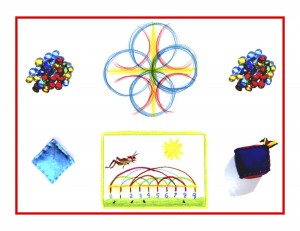Day 96
For one year, 365 days, this blog will address the Common Core Standards from the perspective of creating an alternate, ambient learning environment for math. Ambient is defined as “existing or present on all sides, an all-encompassing atmosphere.” And ambient music is defined as: “Quiet and relaxing with melodies that repeat many times.”
Why ambient? A math teaching style that’s whole and all encompassing, with themes that repeat many times through the years, is most likely to be effective and successful. Today’s post will continue with the Common Core Standards for Grade 1, listed in blue and followed by their ambient counterparts.
Operations and Algebraic Thinking 1.OA
Represent and solve problems involving addition and subtraction.
2. Solve word problems that call for addition of three whole numbers whose sum is less than or equal to 20, e.g. by using objects, drawings, and equations with a symbol for the unknown number to represent the problem.
This can be easily demonstrated and carried out using the stories and plays. Here”s an example: “Three villagers needed enough wool to make blankets for their households. They would share in the tasks of washing, carding, and spinning the wool, then equally share the yarn needed to knit warm woolen blankets. Each villager was able to contribute some jewels to buy the wool from the shepherd. Here are the amounts that each could contribute: 2 jewels, 4 jewels, and 5 jewels. What is the sum of the jewels the villagers could give the shepherd for the wool?” The green color strip with four folded squares could be used here, placing 2 glass gems in the first square, 4 in the second, and 5 in the third. The white square, indicating the sum, would be placed in the fourth folded square to hold the sum, 11 gems.
As mentioned yesterday, any of the other spaces could be used for the white square and the question could be rephrased like, “The villagers needed 11 jewels to buy the wool. One villager had 5 and another had 4. How many jewels would the third villager need to add to make 11?” Re the uneven amounts, this could be added, “Some villagers had more jewels than others, but they were happy to make up for those who had less because the poorer villagers took on extra tasks and helped in other ways.”
Math, or any other subject, should not be made to stand alone, apart from life. The moral element is just as if not more crucial, and children constantly need and look for this sort of guidance. This is one of the many reasons that abstract word problems are harmful. They leave a void where moral guidance should be. And beyond that, it is imperative that children be taught from the whole to the parts. For example, the introduction to the numbers should begin with the whole and proceed to parts. Math By Hand suggests that a piece of fruit be cut up to show how 1 can become 2, 2 becomes 4, etc. This comes back for fractions in Grade 4 to show how 1 becomes 2 halves, 2 halves become 4 quarters, etc. Abstraction is the death of learning for a young child, until age 11 or 12 when it can be introduced gradually. Until then, all must be kept whole and concrete.
Knowledge ensues in an environment dedicated to imaginative, creative knowing, where student and teacher alike surrender to the ensuing of that knowledge as a worthy goal. Tune in tomorrow for more Common Core Grade 1 Operations and Algebraic Thinking Standards along with their ambient counterparts.












